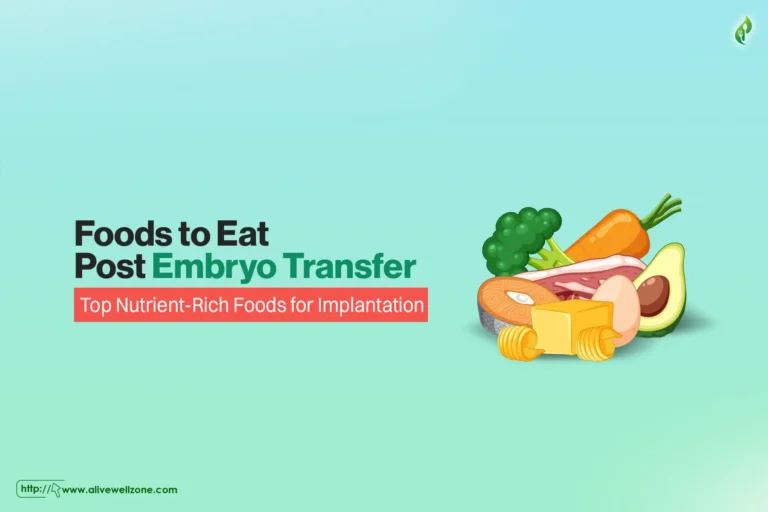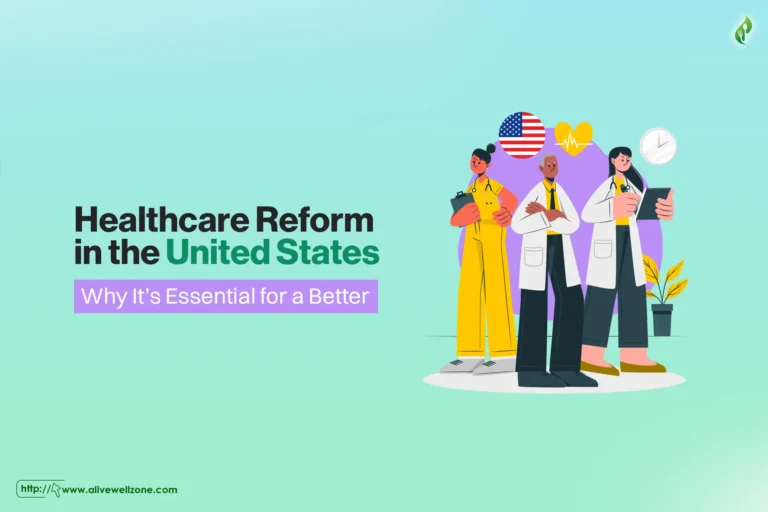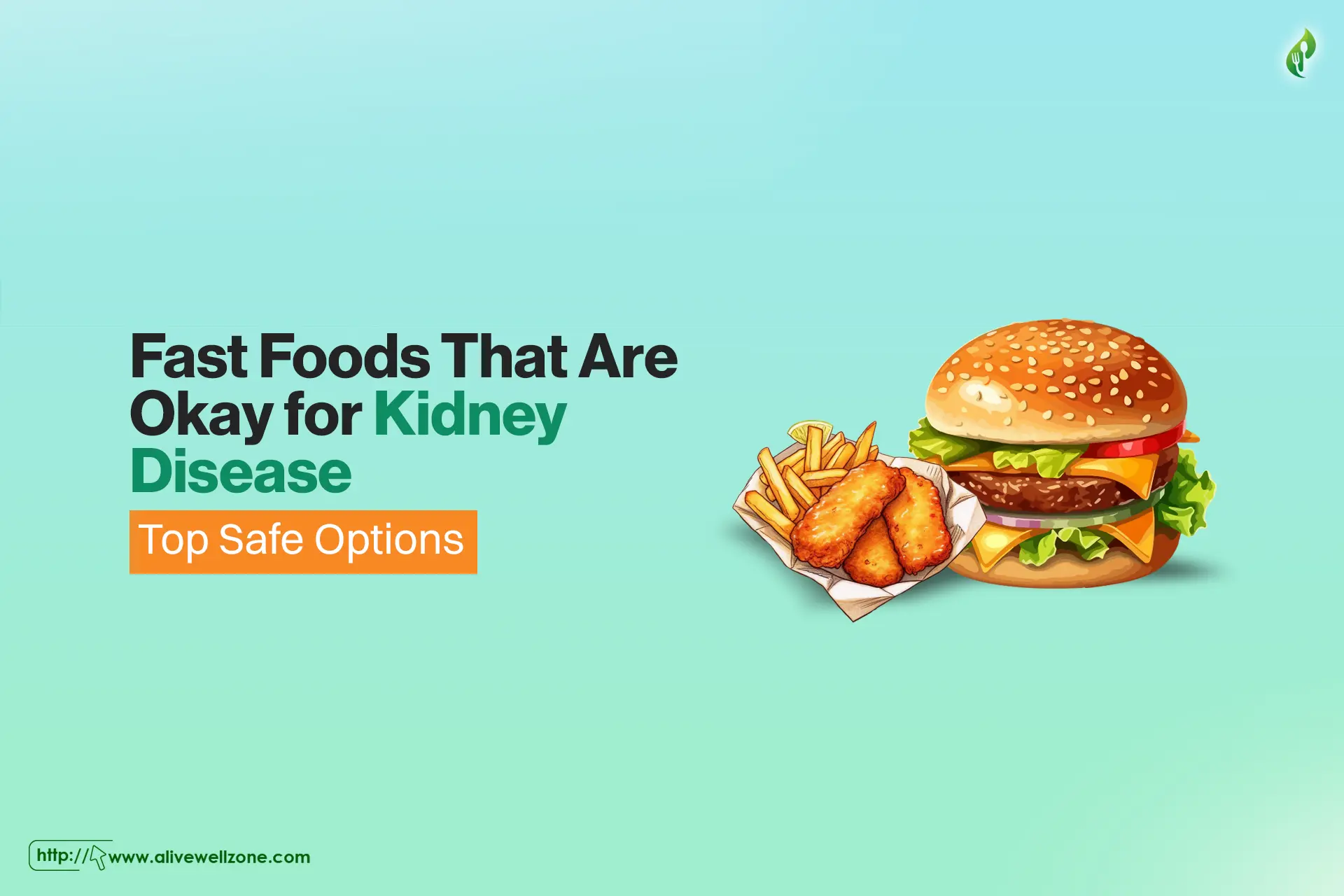
Last Updated on May 20, 2025 by Helena Akter
Are you a fan of fast food but worried about your kidney health? It’s a common dilemma. Many kidney patients feel deprived of their favorite treats. But what if we told you there are fast foods that are okay for kidney disease?
Those fast foods are McDonald’s Fruit & Maple Oatmeal (without cream), and Burger King’s Hamburger. Plus, Taco Bell’s Cheesy Rice and Beans Party Burrito (without cheese), and Chick-fil-A’s Grilled Nuggets. These options are low in sodium, phosphorus, and potassium.
We’ll discuss nutritional considerations and offer recommendations for popular fast-food chains. So, stick with us to make informed choices.
What is a Kidney-Friendly Eating Plan?
A kidney-friendly eating plan helps you stay healthy and slow down kidney damage. It focuses on foods that are easy on your kidneys. Plus, this plan limits foods and drinks that can cause too much potassium and other minerals in your body.
Besides, this diet helps you choose the snacks for kidney problems to keep you safe.
Nutritional Considerations for Kidney Disease
If you have kidney disease, the food you eat is important. The right kidney diet can help protect your kidneys and keep you healthy. Try to eat more nutritious foods fruits, vegetables, and whole grains. In that case, learning how to create healthy food cravings can help you out.
Most importantly, you need to be careful about the following things when you eat —
Maintain Balance
When you eat at fast-food restaurants, try to eat as much fruit and vegetables as you can. Aim for at least 2 servings of fruit and 3 servings of vegetables every day. To make sure you do this, choose foods that are different colors.
Your meal should also have carbohydrates and dietary fiber. See, we need carbohydrates to maintain energy and digestive health.
Besides, you can also get carbs from —
- Bread
- Potatoes
- Pasta
- Tortillas
- Rice
Also, you can consider fiber-rich foods like —
- Oatmeal
- Lentils
- Seeds
- Beans
- Berries
And you might find them in some fast food places, too! These foods also have carbohydrates. So, if you’re wondering what fast food can I eat on a renal diet, these choices can help you manage your diet.
Phosphorus
Phosphorus is found in our food in two ways: naturally occurring and added. Most people with kidney problems don’t need to worry about the natural kind. However, you need to be aware of artificial food additives and their impact on health.
Plus, you must avoid foods with added phosphorus, as it can disrupt kidney health goals. The body absorbs added phosphorus 80% to 100% faster than phosphorus in its natural form, which can spike your phosphorus levels.
Besides, avoiding added phosphates protects your heart and bones. To avoid it, check the ingredient list on food labels, especially for fast food.
Look for ingredients that start with “p-h-o-s.” Be careful with dark sodas! Many dark sodas contain added phosphates, which can contribute to excess phosphorus intake.
Protein
Kidney disease among patients often recommended to eat less protein, especially from meat. Instead, you can choose healthier choices for your kidney diet —
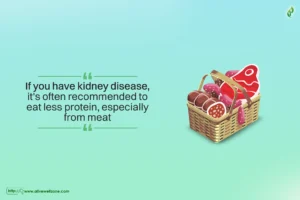
- Beans
- Rice
- Pasta
- Lentils
- Seeds
- Tofu
These plant-based proteins are good for you. You can also eat dairy like almond milk, eggs, and fish, which are better choices than beef.
Sodium
Sodium helps keep your body’s fluids balanced, controls your blood pressure levels, and helps your muscles and nerves work. You should try to eat less than 2,300 milligrams of sodium each day for optimal kidney health goals, which is about 700 milligrams per meal.
However, fast food and common restaurants often have too much sodium, so it can be hard to eat the right amount, especially if you have kidney disease.
Potassium
If you suffer from hypertension, eating the right kind of potassium can help. So, choose foods that are high in fiber and haven’t been processed much, like fresh tomatoes.
Plus, avoid foods with added potassium or processed items like low-sodium ketchup. It’s best to stay away from potassium additives completely. To check if a food has added potassium, look at the ingredients list on fast food websites.
If potassium is listed, it means the food has an additive.
What Fast Food Can I Eat with Kidney Disease?
People with kidney disease need to be careful about what they eat, especially when they eat out. But you can still enjoy fast food if you choose the right items.
So, here is a list of fast foods that are okay for kidney disease. They’re low-sodium, low-phosphorus, and low-potassium fast food options from different restaurants that are good for people with kidney problems.
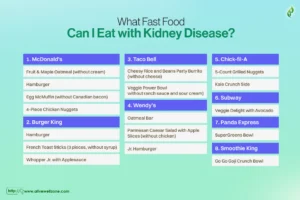
1. McDonald’s
Fruit & Maple Oatmeal (without cream)
- Calories: 300
- Protein: 6 g
- Potassium: 320 mg
- Sodium: 140 mg
- Total Fat: 3 g
- Saturated Fat: 0.5 g
- Carbohydrates: 63 g
- Fiber: 4 g
This oatmeal is a great breakfast choice that aligns with renal nutrition goals. It offers high grams of fiber and low sodium content when ordered without cream. That way, it becomes a kidney friendly way to start your day.
Hamburger
- Calories: 250
- Protein: 12 g
- Potassium: 200 mg
- Sodium: 510 mg
- Total Fat: 9 g
- Saturated Fat: 3.5 g
- Carbohydrates: 31 g
- Fiber: 1 g
McDonald’s classic hamburger is the lowest sodium sandwich among their menu options. So, it’s a suitable choice for those watching their kidney health.
Egg McMuffin (without Canadian bacon)
- Calories: 290
- Protein: 14 g
- Potassium: 160 mg
- Sodium: 550 mg
- Total Fat: 13 g
- Saturated Fat: 6 g
- Carbohydrates: 29 g
- Fiber: 2 g
The Egg McMuffin is a good option when you skip the Canadian bacon. That way, you reduce both sodium and phosphorus content.
4-Piece Chicken Nuggets
- Calories: 170
- Protein: 9 g
- Potassium: 140 mg
- Sodium: 340 mg
- Total Fat: 10 g
- Saturated Fat: 1.5 g
- Carbohydrates: 10 g
- Fiber: 0 g
Pair with a small fry or apple slices for a balanced, kidney friendly fast food.
2. Burger King
Hamburger
- Calories: 250
- Fiber: 1 g
- Protein: 13 g
- Sodium: 560 mg
- Total Fat: 10 g
- Saturated Fat: 4 g
- Carbohydrates: 29 g
This plain hamburger is a lower sodium option compared to other sandwiches. So, it won’t turn into a meal that’s harmful to any stage of kidney disease.
French Toast Sticks (3 pieces, without syrup)
- Calories: 230
- Protein: 6 g
- Sodium: 220 mg
- Total Fat: 10 g
- Saturated Fat: 2 g
- Carbohydrates: 32 g
- Fiber: 2 g
Burger King’s French Toast Sticks, when eaten without syrup, are a lighter breakfast choice with manageable sodium levels.
Whopper Jr. with Applesauce
- Calories: 310 (without ketchup and mayo)
- Protein: 15 g
- Sodium: 360 mg
- Total Fat: 14 g
- Saturated Fat: 4 g
- Carbohydrates: 31 g
- Fiber: 2 g
Remove the ketchup and mayo to reduce sodium further. Pair with applesauce for a serving of fruit.
3. Taco Bell
Cheesy Rice and Beans Party Burrito (without cheese)
- Calories: 500
- Protein: 8 g
- Sodium: 480 mg
- Total Fat: 9 g
- Saturated Fat: 3 g
- Carbohydrates: 78 g
- Fiber: 12 g
Skip the cheese and add guacamole for more vegetables and a lower sodium count.
Veggie Power Bowl (without ranch sauce and sour cream)
- Calories: 790 (after modifications)
- Protein: 12 g
- Sodium: 790 mg
- Total Fat: 18 g
- Saturated Fat: 4 g
- Carbohydrates: 52 g
- Fiber: 11 g
A colorful, fiber-rich meal that’s low in protein and can be made more kidney-friendly by omitting ranch and sour cream.
4. Wendy’s
Oatmeal Bar
- Calories: 280
- Protein: 3 g
- Potassium: 94 mg
- Sodium: 230 mg
- Total Fat: 10 g
- Saturated Fat: 4 g
- Carbohydrates: 45 g
- Fiber: 4 g
Wendy’s Oatmeal Bar is a balanced breakfast option that provides fiber with low sodium, making it a safe choice for kidney health.
Parmesan Caesar Salad with Apple Slices (without chicken)
- Calories: 370
- Protein: 12 g
- Sodium: 370 mg
- Total Fat: 22 g
- Saturated Fat: 7 g
- Carbohydrates: 21 g
- Fiber: 3 g
Ask for no chicken and pair with a pomegranate vinaigrette dressing to reduce sodium.
Jr. Hamburger
- Calories: 250
- Protein: 13 g
- Potassium: 188 mg
- Sodium: 420 mg
- Total Fat: 11 g
- Saturated Fat: 4 g
- Carbohydrates: 25 g
- Fiber: 1 g
The Jr. Hamburger from Wendy’s is another good choice with lower sodium, fitting well into a kidney-friendly diet.
5. Chick-fil-A
5-Count Grilled Nuggets
- Calories: 130
- Protein: 16 g
- Sodium: 270 mg
- Total Fat: 3 g
- Saturated Fat: 1 g
- Carbohydrates: 1 g
- Fiber: 0 g
These grilled nuggets are a great choice for a high-protein, low-sodium entrée at Chick-fil-A. Pair them with a fruit cup for a balanced meal.
Kale Crunch Side
- Calories: 120
- Protein: 4 g
- Sodium: 250 mg
- Total Fat: 9 g
- Saturated Fat: 1 g
- Carbohydrates: 8 g
- Fiber: 4 g
A nutritious side that adds fiber and protein without excessive sodium.
6. Subway
Veggie Delight with Avocado
- Calories: 230
- Protein: 8 g
- Sodium: 269 mg
- Total Fat: 8 g
- Saturated Fat: 1 g
- Carbohydrates: 45 g
- Fiber: 7 g
Subway’s Veggie Delight with Avocado is a nutritious, kidney-friendly choice, rich in fiber and low in sodium.
7. Panda Express
SuperGreens Bowl
- Calories: 90
- Protein: 9 g
- Sodium: 260 mg
- Total Fat: 3 g
- Saturated Fat: 0.5 g
- Carbohydrates: 12 g
- Fiber: 4 g
It’s a low-calorie, low-sodium option with a good balance of protein and fiber.
8. Smoothie King
Go Go Goji Crunch Bowl
- Calories: 320
- Protein: 4 g
- Sodium: 170 mg
- Total Fat: 6 g
- Saturated Fat: 1 g
- Carbohydrates: 64 g
- Fiber: 8 g
This smoothie bowl is a nutrient-dense meal with minimal sodium. It’s perfect for lunch or breakfast.
Is the Impossible Burger Kidney Friendly?
The Impossible Burger is not kidney-friendly, especially for those with chronic kidney disease (CKD) or dialysis patients. Though it’s a plant-based option, it contains high sodium levels (1,080 mg) and significant saturated fat. So, it’s unsuitable for a renal diet.
This is even higher than the traditional beef Whopper, which contains 980 milligrams. In addition, the Impossible Burger has high saturated fat content; just one patty has more than ½ of the daily allowed limit.
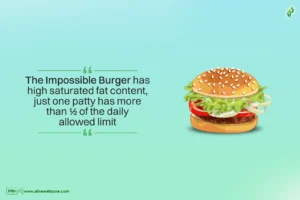
If you have chronic kidney disease (CKD) and need to watch your sodium and protein intake, the Impossible Burger isn’t a good choice. It has 25 grams of protein and a lot of sodium.
So, if you want a lower sodium meal, you could try a Whopper Jr. It has 390 milligrams of sodium. Or you could get a plain hamburger, which has 380 milligrams of sodium.
These options are better for people with kidney health problems.
How Much Fast Food is Okay for Kidney Disease?
For individuals with kidney disease, it’s recommended to limit fast food consumption to one meal per week or less. Usually, it depends on the stage of the disease and dietary restrictions.
Look, fast food is high in amounts of sodium, phosphorus, and potassium. And they’re nutrients that must be carefully managed in kidney disease.
So, here’s a breakdown of the key points you need to remember —
- Frequency: Limiting fast food to once per week helps manage overall sodium, phosphorus, and potassium intake.
- Portion size: Opting for smaller portions or “junior” meals reduces the amount of restricted nutrients and calories.
- Drink size: Keeping drinks to around 10 to 12 ounces helps control fluid retention and prevent fluid overload. It’s vital for kidney disease patients, especially those on dialysis or with advanced kidney function loss.
This strategy allows occasional indulgence without overwhelming the kidneys with excess salt, fluids, or problematic nutrients.
Tips for Selecting Kidney-Friendly Fast Food
With a little awareness, you can still enjoy fast food without loading up on salt, phosphorus, or potassium.
Reading and Understanding Nutritional Labels
When you’re holding a food package, flip it over and check the Nutrition Facts. This label tells you a lot if you know what to look for.
So, start with sodium. If one serving has more than 20% of your daily sodium value in amounts of salt, it’s high. Try sticking to foods with less than 700mg of sodium whenever you can.
Next, check the serving size. Nutrition facts usually reflect one serving only. If you eat two, you’re getting twice the salt, fat, and calories.
Managing Portion Sizes
When it comes to fast food, less really is more. It’s best to choose the smallest portion available. Also, skip double patties or anything super-sized.
A single-patty burger is usually enough.
The best thing to do is to check the menu online ahead of time. It helps you figure out what works best for you. Also, think about what you’ve eaten earlier in the day to keep your meal plan balanced.
Reducing Sodium Intake with Smart Choices
Fast food meals are often packed with salt, even in things you wouldn’t expect, like bread or cheese. To lower your intake —
- Ask for sauces and dressings on the side or leave them out entirely.
- Avoid processed cheese. It’s salty and may also contain phosphorus additives.
- Choose grilled or baked meats instead of fried ones.
- Add fresh veggies like tomatoes, lettuce, or onions to your meal. They’re low in sodium and help you stay full longer.
And if it’s possible, ask for no added salt or a low-sodium option.
Identifying and Avoiding Phosphate Additives
Phosphates are often added to packaged foods to increase flavor or shelf life. However, they’re not friendly to your kidneys.
Look for ingredients ending in -phosphate or anything starting with PHOS. These are signs of added phosphorus.
The tricky part? Phosphorus doesn’t always show up on the nutrition label. So when you’re unsure, go for less processed foods. And if your doctor has given you phosphate binders, remember to carry them with you and take them with your meal.
Final Words
Finally, we’ve explored the fast foods that are okay for kidney disease. It’s clear that with careful choices, you can still enjoy fast food while managing your kidney disease.
Remember, look for low-sodium, low-phosphorus, and low-potassium options. And don’t forget to balance your meal with fruits, vegetables, and whole grains.
As the fast food industry continues to grow, we can expect more options that cater to dietary restrictions like kidney disease. So, keep an eye out for new menu items and don’t hesitate to ask for modifications.
FAQs of fast foods that are okay for kidney disease
Is pizza ok for kidney disease?
Yes, pizza can be kidney-friendly with careful choices. For that, you need to opt for a thick crust to eat more bread than toppings. Also, skip high-potassium items like tomatoes and mushrooms. Plus, avoid extra cheese to limit phosphorus, and go easy on processed meats to reduce sodium.
Is ice cream bad for the kidneys?
No, ice cream is not kidney-friendly, especially for those with advanced kidney disease. It’s high in phosphorus, calcium, protein, and potassium, which can strain the kidneys. Limiting dairy intake is crucial to managing these nutrients.
Is rice ok for kidney disease?
Rice is generally safe for kidney disease. In the early stages, all types are fine, but for those limiting potassium and phosphorus, wild or white rice is better than brown, as it contains less of these minerals.


